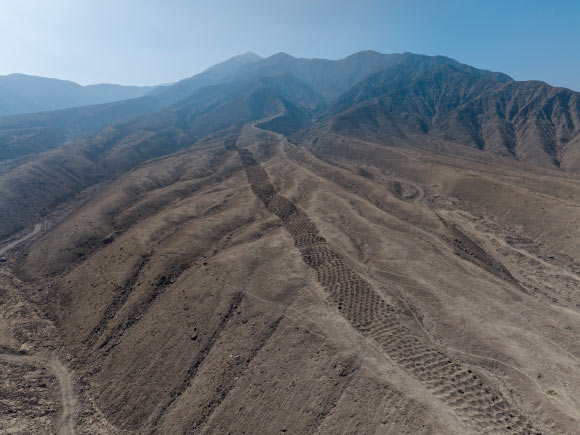Monte Sierpe (translated as ‘serpent mountain’ and known colloquially as the ‘Band of Holes’) is located in the Pisco Valley of southern Peru and consists of approximately 5,200 precisely aligned holes. New research suggests that this archaeological site was originally a barter marketplace, bringing diverse people together for trade and exchange.
Stretching 1.5 km across the Pisco Valley of the southern Peruvian Andes, Monte Sierpe is a large row of approximately 5,200 precisely aligned holes (1-2 m wide and 0.5-1 m deep), organized into sections or blocks.
This remarkable construction likely dates to at least the Late Intermediate Period (CE 1000-1400) and saw continued use by the Inca (CE 1400-1532).
It first gained modern attention in 1933, when aerial photographs of the holes were published in National Geographic, but the monument’s purpose is still uncertain.
Hypotheses regarding its purpose range from defense, storage, and accounting to water collection, fog capture and gardening, yet the true function of the site remains unclear.
“Why would ancient peoples make over 5,000 holes in the foothills of southern Peru? Were they gardens? Did they capture water? Did they have an agricultural function?” said Dr. Jacob Bongers, a digital archaeologist at the University of Sydney.
“We don’t know why they are here, but we have produced some promising new data that yield important clues and support novel theories about the site’s use.”
Using drone technology, Dr. Bongers and colleagues mapped the site and found numerical patterns in the layout that hint at an underlying intention in the site’s organization.
To their surprise, the archaeologists also discovered that the arrangement of Monte Sierpe is similar to the structure of at least one Inca khipu (an ancient knotted-string accounting device) that was recovered from the same valley.
“This is an extraordinary discovery that expands understandings about the origins and diversity of Indigenous accounting practices within and beyond the Andes,” Dr. Bongers said.
Analyses of soil from the holes found ancient pollens of maize (corn), one of the most important staple crops in the Andes, and reeds that have traditionally been used over millennia for making baskets.
These unexpected findings importantly indicate that people deposited plants in the holes, using woven baskets and/or bundles for transport.
“This is very intriguing. Perhaps this was a pre-Inca marketplace, like a flea market,” Dr. Bongers said.
“We know the pre-Hispanic population here was around 100,000 people. Perhaps mobile traders (seafaring merchants and llama caravans), specialists (farmers and fisherfolk), and others were coming together at the site to exchange local goods such as corn and cotton.”
“Fundamentally, I view these holes as a type of social technology that brought people together, and later became a large-scale accounting system under the Inca Empire.”
“There are still many more questions — why is this monument only seen here and not all over the Andes?”
“Was Monte Sierpe a sort of ‘landscape khipu’? — but we are getting closer to understanding this mysterious site. It is very exciting.”
The study was published November 10, 2025 in the journal Antiquity.
_____
Jacob L. Bongers et al. Indigenous accounting and exchange at Monte Sierpe (‘Band of Holes’) in the Pisco Valley, Peru. Antiquity, published online November 10, 2025; doi: 10.15184/aqy.2025.10237








